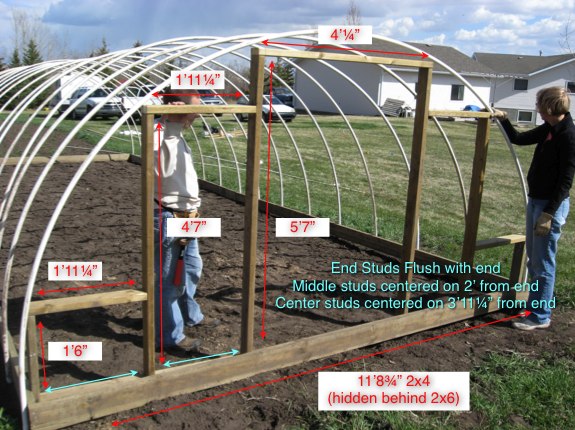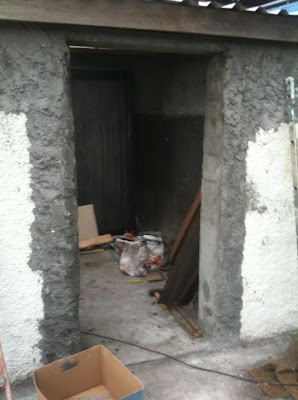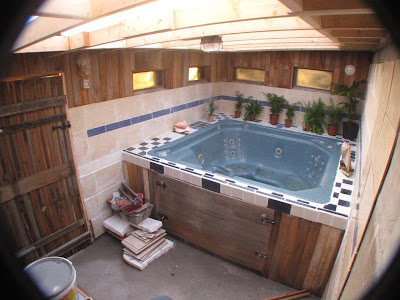I'm a hoarder. I like to collect things people don't use anymore and give them a new life.
I'm a firm believer that re-use is the way to helping the environment.
All these new eco products are great but have one major downside : They're all new manufactured products. How can you help the environment by taking more resources and making yet new stuff.
Reuse instead.
Anyway, when I moved to my new house, I new there was something nice to be done with the old water collectors.
I started with cleaning up the area. I wasn't sure what I was going to do with it yet, I just knew I had to do something. The "only" challenge was I had no experience whatsoever in building projects ...
Once it was all cleared of vegetation, I emptied the tank and started making an opening in the 1ft thick wall... turns out, I spent a fortune on plasters and band aids.
In the meantim, spring arrived and we decided to paint the sad looking walls of our little cottage house. Everything looks better with a bit o' paint.
Next, I finished the opening (about 1m wide) and finished the paths around the house. These are very important for any house as they help dry the walls and help prevent dampness inside. Also it's much easier to walk around the house when it's wet.
I left this project at that for a few months, trying to decide what to do next. I also sorted the paperwork. luckily, the structure was exempt from planning permission.
When friends approached me and told me they were getting rid of their hot tub, I instantly knew this was the right place for it. And it kept witht he theme of water ... water collector - hot tub ... right ? right ? get it ?
Anyway, it made sense in my head. I'll spare you the dismantling part (it came in a wooden shed type of structure ... and yes, I kept all the wood) and transport but we eventually got it on our grounds.
The opening was just wide enough to allow to slide the thing in on it's side.
I had to get some of the pipes fixed for leaks and a friend of mine looked after the electrics. Luckily again, most of the electrical components were in working order, bar the heating element. I was fried and beyond fixing. A quick look on ebay, and I had the element in my letter box.
I used some of the wood I had to secure and level the tub itself and used the old windows from the old shed structure to make new ones ; double glazed !
I was time to start on the building part.
Once I raised the walls high enough and plastered them, it was time to put the roof down. I had been gathering 2x4 here and there in the meantime (skip, building sites, friends ... ) so i only had to get and extra 4 or 5 to make the whole roof structure.
I got some shed roofing sheets from a local company. There's a 8x12 patch of transparent sheeting. It lets plenty of light in during the day and makes heats up the place naturaly. The downside is that once the sun is down, heat loss occur quickly as there's no roof insulation. However by then you're either in the tub, or it's covered with the insulated sheets of foam.
I realised too late that I should've finished the external plaster first as well as the leveling of the door walls. It's not too difficult to do at this stage but was a bit more cumbersome than it needed to be.
And that's the structural building done (just needs a bit o' paint...) . It's not a pro finish I know, but it's my first building project and I'm pretty proud of it.
Next comes tilling, sawing, hammering, cladding, cursing...
I had been collecting old wood, tiles, bags of cement etc... over the years so I had everything handy.
I made an old door using the wood from the old shed. A bit of advice, when you put it down, make sure you can still open it from the inside...
The tub is now working and the room is fully tiled. I will also do a big mural painting of a wave on the back wall (where the picture is taken) to look at when you're in the tub.
I got some blocks of kingspan insulation foam from a local building site ( I asked the guys working there if they had any leftovers and i ended up with 4 full sheets) and fully insulated the roof.
I then made a small unit with wood leftovers and broken tiles. handy to store the towels and a few fresh cans ... and a little home made mural painting.









.JPG)
.JPG)
.JPG)
(1).JPG)



.jpg)


.JPG)





































